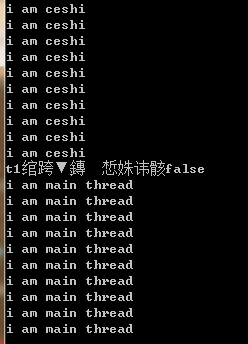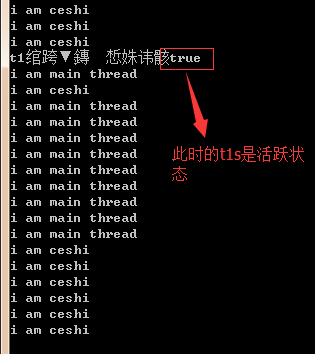join()方法表示一个线程要加入另一个线程,直到被加入的线程执行完毕。
这个概念不好理解的话看面这个例子
1 public class TestJoin {
2 public static void main(String[] args) {
3 MyThread2 t1 = new MyThread2("ceshi");
4 t1.start();
5 try {
6 t1.join(); //执行到这个方法时,主线程会等着t1线程执行结束才会继续执行
7 System.out.println("t1线程是否死亡"+t1.isAlive());//此时t1线程已经执行完毕终止掉了
8 } catch (InterruptedException e) {}
9
10 for(int i=1;i<=10;i++){
11 System.out.println("i am main thread");
12 }
13 }
14 }
15 class MyThread2 extends Thread {
16 MyThread2(String s){
17 super(s);
18 }
19
20 public void run(){
21 for(int i =1;i<=10;i++){
22 System.out.println("i am "+getName());
23 try {
24 sleep(1000);
25 } catch (InterruptedException e) {
26 return;
27 }
28 }
29 }
30 }
上面这个例子是已开始有主线程main,然后创建了个 t1 线程 ti线程调用了join方法。就把线程主线程暂停了等待着 t1 线程执行完毕,等 t1 线程执行结束后,t1线程终止。主线程main继续执行直至结束。
执行结果为:

join的本质是让调用线程wait()在当前线程实例上
因为jdk实现join的代码为


1 public final synchronized void join(long millis)
2 throws InterruptedException {
3 long base = System.currentTimeMillis();
4 long now = 0;
5
6 if (millis < 0) {
7 throw new IllegalArgumentException("timeout value is negative");
8 }
9
10 if (millis == 0) {
11 while (isAlive()) {
12 wait(0);
13 }
14 } else {
15 while (isAlive()) {
16 long delay = millis - now;
17 if (delay <= 0) {
18 break;
19 }
20 wait(delay);
21 now = System.currentTimeMillis() - base;
22 }
23 }
24 }
里面核心的代码片段为:

join的三种用法
join() 等待该线程终止。正如上面所介绍
join(long millis)等待该线程终止的时间最长为 millis 毫秒。这个会等待被加入的线程执行 millis多毫秒,等待结束后,线程一起运行。将上面举的例子修改一下
将 t1.join(); 替换成 t1.join(3000);

join(long millis,int nanos) 等待该线程终止的时间最长为millis毫秒 +nanos纳秒。 其余的和 join(long millis)一样。
三种方式如果被打断的话都会抛出InterruptedException异常。
